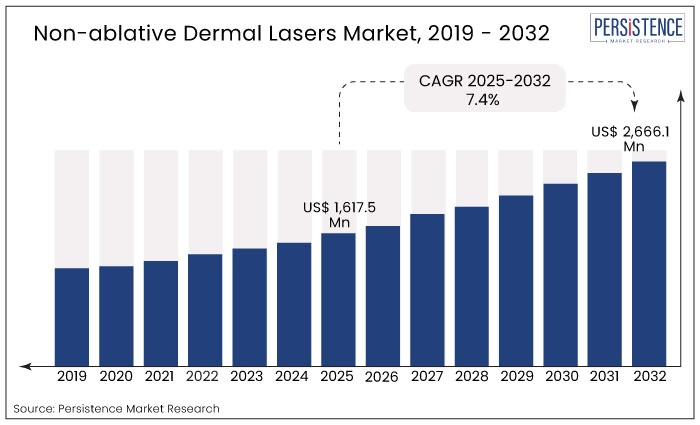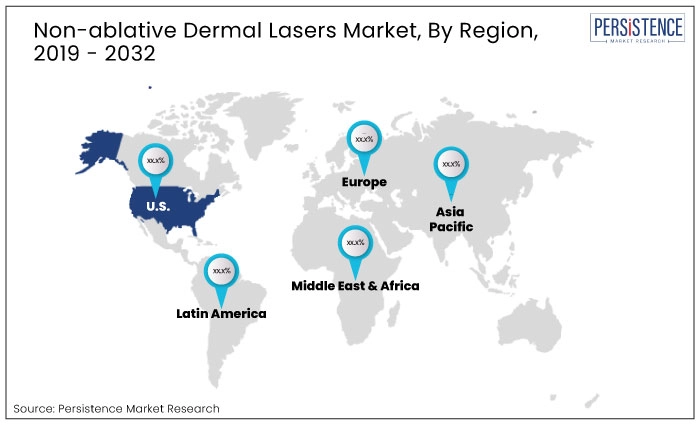ID: PMRREP32979| 198 Pages | 16 Jul 2025 | Format: PDF, Excel, PPT* | Healthcare

As per Persistence Market Research, the global non-ablative dermal lasers market advanced at value of US$ 1,617.5 Mn in 2025. The market is forecasted to expand at a CAGR of 7.4% and reach US$ 2,666.1 Mn by the end of 2032.
Growing demand for minimally invasive cosmetic procedures, driven by people's desire for quick recovery times and minimal discomfort, is expected to significantly impact the future market growth of non-ablative dermal lasers. As people become more self-conscious about their physical appearance, the use of non-ablative dermal lasers, which can improve skin appearance without surgery or a lengthy healing process, is becoming more appealing.
Non-surgical facelifts are becoming more popular among patients since they are less invasive as compared to traditional surgical facelifts. Non-ablative laser treatments can be used as part of a non-surgical facelift, providing a safe and effective way to rejuvenate the skin.
Growing awareness of non-ablative laser treatments will also pave the way for the market to expand during the forecast period. With the rise of social media and other online platforms, more people are becoming aware of non-ablative laser treatments and the benefits they offer. This increased awareness is driving demand for non-ablative dermal laser treatments among both men and women, which will ultimately result in increased adoption of non-ablative dermal lasers in cosmetic & aesthetic treatments.
Non-ablative dermal lasers market growth is expected to be influenced by the increasing aging population across the world. With the global population aging, there is a growing demand for treatments that can reduce the appearance of aging signs such as wrinkles, freckles, and liver spots. Non-ablative laser treatments are popular among older adults as they can improve skin tone, texture, and firmness, without the need for surgery or a lengthy recovery process.
 Non-ablative treatments can be used to improve a range of skin issues, including fine lines and wrinkles, uneven skin tone, and acne scars. This versatility makes them a popular choice among people who want to address multiple skin concerns with a single treatment.
Non-ablative treatments can be used to improve a range of skin issues, including fine lines and wrinkles, uneven skin tone, and acne scars. This versatility makes them a popular choice among people who want to address multiple skin concerns with a single treatment.
|
Non-ablative Dermal Lasers Market Size (2025) |
US$ 1,617.5 Mn |
|
Projected Market Value (2032) |
US$ 2,666.1 Mn |
|
Global Market Growth Rate (2025 to 2032) |
7.4% CAGR |
| Historical Market Growth Rate (CAGR 2019 to 2024) |
5.8% |
“High Focus on Technological Advancements to Enhance Effectiveness & Safety of Non-ablative Dermal Lasers Increasing”
The market is expected to provide growth opportunities for manufacturers due to advancements in laser technology. These advancements are improving the effectiveness and safety of non-ablative lasers, making them a more appealing option for both practitioners and patients. Newer devices offer greater precision, control, and customization, allowing practitioners to tailor treatments to the specific needs of each patient.
Picosecond lasers are a recent innovation in non-ablative laser technology, delivering ultra-fast pulses of laser energy in picoseconds (trillionths of a second). These lasers are highly effective at targeting pigmentation issues, such as age spots and melasma, and are also used for tattoo removal.
Alexandrite lasers are a type of non-ablative laser that is highly effective at targeting hair follicles. These lasers emit a specific wavelength of light that is absorbed by the pigment in the hair, damaging the follicle and preventing further hair growth.
Manufacturers are strategically looking for expansion into new geographical regions to increase their product adoption as well as revenues. Non-ablative dermal laser treatments offer significant growth potential in emerging markets, where disposable incomes are rising, and people are becoming more interested in cosmetic treatments. Expanding into these markets could help drive demand for non-ablative dermal lasers.
Combination treatments have further, created a buzz in the cosmetic industry in recent times. Use of combination treatments has become increasingly popular in recent years, with practitioners combining non-ablative laser treatments with other cosmetic procedures, such as injectables, dermal fillers, and other laser treatments. This approach can provide even better results than using a single treatment alone.
“High Cost of Non-Ablative Laser Treatments and Availability of Affordable Alternatives”
Non-ablative dermal lasers may face stiff competition from other products, such as dermal fillers, Botox, and surgical procedures. Patients may choose these other options over non-ablative lasers depending on their individual needs and preferences. Wide availability of alternative cosmetic treatments can potentially reduce the adoption of non-ablative laser treatments, this could impede market growth.
The high cost of non-ablative laser treatment is another factor that could potentially impede market growth. Non-ablative laser treatments can be expensive, particularly when compared to other cosmetic treatments, and this high cost could be a barrier for some patients.
There are several reasons why non-ablative laser treatments are relatively expensive. The technology used in these treatments is often sophisticated and requires significant investment in research and development. Non-ablative laser treatments are typically performed by licensed healthcare professionals, such as dermatologists or plastic surgeons, who charge a premium for their expertise. The cost of laser devices can be high, particularly for newer or more advanced technologies.
Regulations and standards for non-ablative laser treatments vary across regions. These regulations can be complex and may limit the availability or use of certain devices, affecting demand for non-ablative dermal lasers.
Why is the United States a Lucrative Market for Manufacturers of Non-Ablative Dermal Lasers?
“Supportive Regulatory Framework for Application of Non-ablative Dermal Lasers”
The United States accounted for 58.3% share of the global market in 2024.
Demand for non-ablative dermal laser treatments in the United States is growing substantially, particularly among older individuals and those with a higher disposable income.
The United States is home to a large number of leading manufacturers and suppliers of non-ablative laser devices. These companies invest heavily in research and development, resulting in some of the most advanced and effective laser devices available on the market today. The regulatory environment in the country is generally favorable to the development and use of non-ablative laser treatments. These factors have led to the domination of the United States in the global market
How is Demand for Non-ablative Dermal Lasers Shaping Up in China?
“Increasing Awareness of Benefits of Cosmetic Treatments”
China held 4.5% share of the global non-ablative dermal lasers market in 2024.
China has a large and rapidly growing population, including a growing middle class with disposable income to spend on cosmetic treatments, making it a potentially lucrative market for non-ablative lasers.
In recent years, there has been a significant increase in demand for cosmetic treatments in China, including non-ablative laser treatments. This growth is due to several factors, including increased awareness of the benefits of cosmetic treatments, a desire to look youthful and attractive, and a cultural emphasis on physical appearance.
Investments in research, product development, partnerships, and emphasis on regulatory compliance can help manufacturers and suppliers of non-ablative laser devices to develop a competitive edge in the market.
What is the Outlook for Non-ablative Dermal Lasers in Canada?
“Availability of Insurance Coverage for Non-surgical Cosmetic Treatments Driving Demand for Non-ablative Lasers”
Demand for non-ablative dermal lasers in Canada accounted for 3.2% of the global market in 2024.
Canada has a publicly funded healthcare system that provides universal coverage to all residents. This system includes coverage for non-surgical cosmetic treatments like non-ablative dermal laser treatments, which makes these treatments more accessible to the population.
Like many other developed countries, demand for non-surgical cosmetic treatments is growing in Canada. Canada is home to many leading medical device manufacturers, including those that specialize in non-ablative laser technology. These companies invest heavily in research and development, resulting in some of the most advanced and effective laser devices in the market.

Which Product Segment Accounts for High Sales?
“Fewer Side Effects and High Efficacy of Solid-state Lasers”
The solid-state lasers segment held 93.9% share of the global market in 2024.
Solid-state lasers are known for their high efficacy in treating a variety of skin conditions, including fine lines, wrinkles, and age spots. They are effective in treating both light and dark skin and can be used to address a range of skin concerns, including acne scars, hyperpigmentation, and vascular lesions. These lasers are widely available and have a lower risk of side effects than other non-ablative lasers.
A combination of high efficacy, versatility, reduced downtime, lower risk of side effects, and wide availability make solid-state lasers a popular choice among healthcare providers and patients for non-ablative laser treatments.
Why are Non-ablative Laser Treatments Extensively Used for Hair Removal?
“Safety & Efficacy of Non-ablative Lasers for Permanent Hair Removal”
By application, the hair removal segment accounted for 19.4% share of the global market in 2024.
Patients often choose non-ablative laser treatments for hair removal because they are safe, effective, and convenient. Non-ablative laser treatments target hair follicles directly, which means that they are more precise and effective than other hair removal methods. Non-ablative laser treatments offer permanent hair reduction and are quick and convenient, often taking less than half an hour or so to complete. While laser treatments can be more expensive than other hair removal methods, such as waxing or shaving, they are an effective long-term solution.
Which End User Occupies a Leading Share of the Market?
“Increased Adoption of Laser Treatments at Dermatology and Cosmetic Clinics Due to Practitioners’ Proficiency & High-quality Care”
The dermatology & cosmetic clinics segment held 69.5% of the global market share in 2024.
Dermatology and cosmetic clinics employ trained and experienced medical professionals who specialize in skincare and laser treatments. The knowledge and proficiency gained by practitioners can enhance patient confidence in their services, increasing the likelihood of them selecting non-ablative laser treatments.
Dermatology and cosmetic clinics often have a reputation for providing high-quality care and achieving excellent results. Dermatology and cosmetic clinics typically offer a wide range of non-ablative laser treatments for various skin conditions. This range of services allows them to cater to a broad patient base and capture a larger market share.
The non-ablative dermal lasers market is competitive and diverse with several market players offering a variety of solutions for different applications. As the market continues to grow, there is a rise in innovation and competition among players. There are also several emerging companies entering the market. These companies often focus on developing innovative technologies for targeting niche markets.
Similarly, the team at Persistence Market Research has tracked recent developments related to companies in the non-ablative dermal lasers market, which are available in the full report.
The market is expected to reach US$ 2,666.1 Mn by 2032.
The market is forecasted to grow at a CAGR of 7.4%.
Solid-state lasers dominate with 93.9% market share in 2024.
Dermatology & cosmetic clinics dominate with 69.5% market share in 2024.
The United States leads with 58.3% of the global market in 2024.
China’s rising cosmetic awareness and Canada’s insurance support drive market growth.
|
Attributes |
Details |
|
Forecast Period |
2025 to 2032 |
|
Historical Data Available for |
2019 to 2024 |
|
Market Analysis |
Value: US$ Bn, Volume: As applicable |
|
Key Countries Covered |
|
|
Key Market Segments Covered |
|
|
Key Companies Covered |
|
| Report Highlights |
|
|
Customization & Pricing |
Available upon Request |
Product:
Application:
End User:
Region:
Delivery Timelines
For more information on this report and its delivery timelines please get in touch with our sales team.
About Author